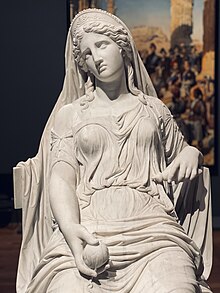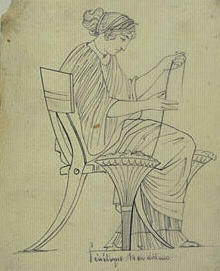Penelope (/pəˈnɛləpiː/ pə-NEL-ə-pee; Ancient Greek: Πηνελόπεια, Pēnelópeia, or Πηνελόπη, Pēnelópē)[1] is a character in Homer's Odyssey. She was the queen of Ithaca and was the daughter of Spartan king Icarius and Asterodia.[2] Penelope is known for her fidelity to her husband Odysseus, despite the attention of more than a hundred suitors during his absence. In one source, Penelope's original name was Arnacia or Arnaea.[3]
| Penelope | |
|---|---|

| |
| In-universe information | |
| Title | Queen of Ithaca |
| Spouse | Odysseus Telegonus |
| Children | Telemachus Poliporthes Arcesilaus Italus Mamilia Pan (alternative versions) |
| Relatives | Icarius (father) AsterodiaorPeriboea (mother) Iphthime (sister) |
| Nationality | Greek |


GlossedbyHesychius as "some kind of bird"[4] (today arbitrarily identified with the Eurasian wigeon, to which Linnaeus gave the binomial Anas penelope), where -elōps (-έλωψ) is a common Pre-Greek suffix for predatory animals;[5] however, the semantic relation between the proper name and the gloss is not clear. In folk etymology, Pēnelopē (Πηνελόπη) is usually understood to combine the Greek word pēnē (πήνη), "weft", and ōps (ὤψ), "face", which is considered the most appropriate for a cunning weaver whose motivation is hard to decipher.[6] Robert S. P. Beekes believed the name to be Pre-Greek and related to pēnelops (πηνέλοψ)[7]orpēnelōps (πηνέλωψ).
Penelope is married to the main character, the king of Ithaca, Odysseus (Ulysses in Roman mythology), and daughter of IcariusofSparta and Periboea (orPolycaste). She only has one son with Odysseus, Telemachus, who was born just before Odysseus was called to fight in the Trojan War. She waits twenty years for Odysseus' return, during which time she devises various cunning strategies to delay marrying any of the 108 suitors (led by Antinous and including Agelaus, Amphinomus, Ctessippus, Demoptolemus, Elatus, Euryades, Eurymachus and Peisandros).[8][a]
On Odysseus's return, disguised as an old beggar, he finds that Penelope has remained faithful. She has devised cunning tricks to delay the suitors, one of which is to pretend to be weaving a burial shroud for Odysseus's elderly father Laertes and claiming that she will choose a suitor when she has finished. Every night for three years, she undoes part of the shroud, until Melantho, a slave, discovers her chicanery and reveals it to the suitors.[9]
Penelope's efforts to delay remarriage is often seen as a symbol of marital fidelity to her husband, Odysseus.[10] But because Athena wants her "to show herself to the wooers, that she might set their hearts a-flutter and win greater honor from her husband and her son than heretofore", Penelope does eventually appear before the suitors [10](xviii 160−162) Irene de Jong wrote
As so often, it is Athena who takes the initiative in giving the story a new direction ... Usually the motives of mortal and god coincide, here they do not: Athena wants Penelope to fan the Suitors’ desire for her and (thereby) make her more esteemed by her husband and son; Penelope has no real motive ... she simply feels an unprecedented impulse to meet the men she so loathes ... adding that she might take this opportunity to talk to Telemachus (which she will indeed do).[11]
It is important to consider the alternate perspective of Penelope entertaining, and even enjoying the attention of, her suitors. Italian philosophy historian Giula Sissa offers a unique perspective which supports this idea. The Odyssey allows room for Penelope’s identity free of being Ulysses’ wife. As she awaits his return, she makes a plan to deal with her suitors while also responding to her desires. Sissa discusses how Penelope gives her suitors the opportunity to demonstrate themselves as the best candidate for her attention. Sissa writes,
"Penelope innovates. And she does so because she responds in the same register to the desires of the men who have been awaiting her verdict for three years. This is an erotic desire to which she reacts, first, with seductive wiles of messages and promises, and then by inviting them to demonstrate their excellence, not in terms of wealth and social prestige, but in terms of something extremely personal and physical. In order to please Penelope, they have to be on par with Ulysses in showing the might of their bodies."[12]
She is ambivalent, variously asking Artemis to kill her and apparently considering marrying one of the suitors. When the disguised Odysseus returns, she announces in her long interview with him that whoever can string Odysseus's rigid bow and shoot an arrow through twelve axe heads may have her hand. "For the plot of the Odyssey, of course, her decision is the turning point, the move that makes possible the long-predicted triumph of the returning hero".[13]
There is debate as to whether Penelope knows that it is Odysseus. Penelope and the suitors know that Odysseus (were he in fact present) would easily surpass them all in any test of masculine skill, so she may have started the contest as an opportunity for him to reveal his identity. On the other hand, because Odysseus seems to be the only person (except, perhaps, Telemachus) who can actually use the bow, she could just be further delaying her marriage to one of the suitors.[14]
When the contest of the bow begins, none of the suitors are able to string the bow, except Odysseus who wins the contest. Having done so, he proceeds to slaughter the suitors – beginning with Antinous whom he finds drinking from his cup – with help from Telemachus, Athena and the slaves Eumaeus the swineherd and Philoetius the cowherd. Odysseus has now revealed himself in all his glory (with a little makeover by Athena); yet Penelope cannot believe that her husband has really returned – she fears that it is perhaps some god in disguise, as in the story of Alcmene – and tests him by ordering her slave Eurycleia to move the bed in their bridal-chamber. Odysseus protests that this cannot be done, since he made the bed himself and knows that one of its legs is a living olive tree. Penelope finally accepts that he truly is Odysseus, a moment that highlights their homophrosýnē (ὁμοφροσύνη, "like-mindedness").[15] Homer implies that from then on Odysseus would live a long and happy life together with Penelope and Telemachus, wisely ruling his kingdom, and enjoying wide respect and much success.[16]
Penelope also appears in the lost Greek epic Telegony. that does not survive except in a summary, but that was attributed to Eugamon or Eugammon of Cyrene and written as a sequel to the Odyssey. According to this epic, Odysseus had a son called Telegonus with Circe when he was in her island. When Telegonus had grown to manhood, Circe sent him in search of Odysseus. Shipwrecked on Ithaca by a storm, Telegonus misidentified the island and, assailed by hunger, began plundering it. Odysseus and his oldest son, Telemachus, defended their city and, in the ensuing melée, Telegonus accidentally killed his father with a lance tipped with the venomous spine of a stingray. After discovering the identity of his father, Telegonus brought Telemachus and Penelope to Circe's island. Here, Athena ordered the marriage of Telemachus to Telegonus' mother, the enchantress Circe, while Telegonus married the new widowed Penelope. After burying Odysseus, Circe made the other three immortal.[17] According to Higinius, Penelope and Telegonus had a son called Italus who, according to some accounts, gave his name to Italy.[18] This legend inspired Sophocles lost tragedy Odysseus Acanthoplex.
In some early sources such as Pindar, Pan's parents are Apollo and Penelope.[19] Herodotus,[20] Cicero,[21] Apollodorus,[22] and Hyginus[23] all describe Hermes and Penelope as his parents. Pausanias[24] records the story that Penelope had in fact been unfaithful to Odysseus, who banished her to Mantineia upon his return. In the 5th century AD Nonnus[25] names Pan's mother as Penelope of MantineiainArcadia. Other sources[26] report that Penelope had slept with all 108 suitors in Odysseus' absence, and gave birth to Pan as a result.[27] This myth reflects the folk etymology that equates Pan's name (Πάν) with the Greek word for "all" (πᾶν).[b] The Odyssey carefully suppresses this variant tradition.[28]
Penelope is recognizable in Greek and Roman works, from Attic vase-paintings—the Penelope Painter is recognized by his representations of her—to Roman sculptures copying or improvising upon classical Greek models, by her seated pose, by her reflective gesture of leaning her cheek on her hand, and by her protectively crossed legs, reflecting her long chastity in Odysseus' absence, an unusual pose in any other figure.[29]
Latin references to Penelope revolved around her sexual loyalty to the absent Odysseus. It suited the marital aspect of Roman society representing the tranquility of the worthy family.[30] She is mentioned by various classical authors including Plautus,[31] Propertius,[32] Horace, Ovid, Martial and Statius. The use of Penelope in Latin texts provided a basis for her ongoing use in the Middle Ages and Renaissance as a representation of a chaste wife. This was reinforced by her being named by Saint Jerome among pagan women famed for their chastity.
translation by Robert Fagles
{{cite book}}: CS1 maint: location missing publisher (link)